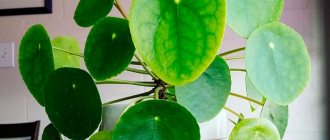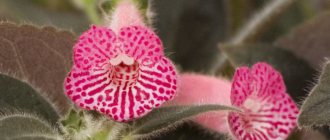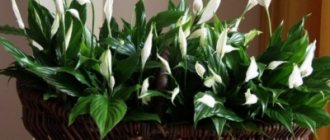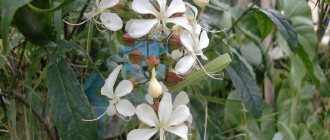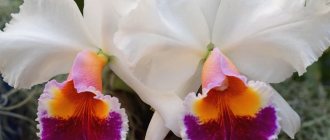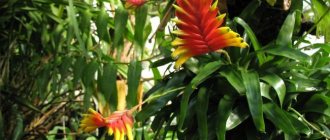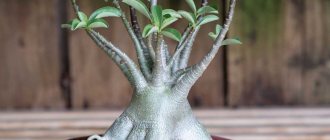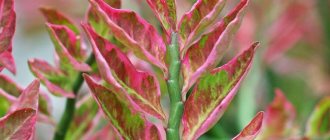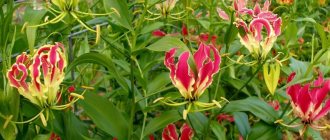Photo of the plant Vriesia is a perennial herbaceous plant of the Bromeliad family.. Vriesia is native to Central and South America. The plant is an epiphyte, it needs roots only for attachment to the substrate, and the function of accumulating and absorbing nutrients is taken over by special reservoirs located at the bases of leaf rosettes.
As it grows, Vriesia forms dense funnel-shaped rosettes of soft or leathery leaves up to 1 m in height. The leaf blade can have different colors: from plain emerald to tiger (with dark and light green stripes) and speckled (with light or brown spots on a dark background). The inflorescences have bright keeled bracts and small, inconspicuous flowers.
You will also be interested in other plants from the bromeliad family: billbergia and aechmea.
| Average growth rate. |
| Vriesia can bloom all year round. |
| The plant is easy to grow. |
| After flowering, Vriesia lives up to 2 years. |
History of Vriesia
This flower was first discovered in the forests of South and Central America. It was studied and described by the Dutch botanist Willem Hendrik de Vriese. The flower was named after him. Its correct name sounds like “friesia” and it would be more correct to call it that way. But in our country, the compilers of the directory of indoor plants, without hesitation, translated it through the first letter “B”. This is where the distortion came from, because of which we call the flower Vriesia.
Important! Do not confuse Frisea (vriesia) with freesia (freesia, lat. Freesia). The latter belongs to the Iris (Kasatikov) family. This is a genus of African perennial herbaceous corms.
Freesia
Botanical description of Vriesia
Vriesia is an ornamental perennial of the Bromeliad family. In its natural habitat, it is an epiphyte, as it prefers to grow by clinging to its taller neighbors. This arrangement gives it an advantage, since the vriesea receives more light and practically does not compete with other plants for water and oxygen.
In nature, it is most often found in the tropics of South and Central America, in the south of Brazil and Argentina, as well as in Western India.
Leathery leaves with smooth edges grow in such a way that a rosette is formed at their base. It serves as a container for collecting rainwater, which the flower feeds on. The leaf width can reach 8 cm, and the length – 80 cm. The color of the plate depends on the variety.
During the flowering period, a peduncle appears; its length can reach 1 meter. Inflorescences are spike-shaped, multi-flowered. The color can be monochromatic or multi-colored, it depends on the variety. The peduncle lasts for a very long time, more than a month. At the end of flowering, a fruit appears in the form of a box with seeds.
The root system of Vriesea is poorly developed; the epiphytes, to which this plant belongs, practically do not use the roots for nutrition, they only cling to the support for life above the surface of the earth. The flower receives all the main nutritional elements from the leaf rosette. In tropical conditions, sometimes up to 4.5 liters of water can accumulate in it.
You may be interested in: All about growing guzmania (guzmania).
3.Varieties:
3.1.Vriesia astrid
A perennial herbaceous evergreen plant from 25 to 40 cm in height with dark green, belt-shaped leaves with a glossy surface, collected in a basal leaf rosette. The leaves are often curved in a graceful arc. Each rosette is capable of forming several short peduncles with bright red bracts at the top, which are the main decoration of the plant for several months. The flowers are small, tubular, bright yellow, and quickly fade.
↑ Up,
3.2.Vriesea carinata Wawra
An evergreen epiphytic herbaceous plant with tall, glossy, arched, wide, belt-shaped leaves, collected in a basal rosette. In the warm season, the rosette forms a low peduncle with one or several branched inflorescences at the top. The inflorescences consist of brightly colored red or yellowish-red bracts and yellow tubular flowers.
↑ Up,
Planting and caring for vriesia depending on the time of year in the table
| Season | Features of watering | Light | Air humidity, % | Temperature |
| Spring | Lightly moisten the soil. Water the outlet 2 times a week, first pouring out the remaining water from the previous watering. | Bright but slightly diffused | 70-80 | +24…+26 °C |
| Summer | Watering the soil is carried out as it dries. The outlet needs to be watered every three days. | During the daytime, it is necessary to cover the plant from direct sunlight. | 70-80. When the temperature rises, it is necessary to spray at least twice a day and place a saucer of water next to the flower. | +24…+32 °C |
| Autumn | Watering is carried out approximately once a week; if the air temperature drops to +20 °C, you need to pour the water out of the outlet. The soil is rarely moistened as it dries. | Bright but diffused light. | 60-80. Spraying is carried out after turning on the central heating once a day. | +18…+24 °C |
| Winter | During the dormant period, the plant is rarely watered; the soil is moistened when it dries completely. If the room is colder than +20 °C, the outlet cannot be humidified. | It is advisable to place the vriesia on the south side. | Humidity is maintained by daily spraying. If the plant is close to the radiator, it can be moistened more often. | +17…+22 °C. At +15 °C additional heating will be required. |
Temperature
Vriesia by its nature and origin is a very heat-loving plant. It is desirable that the room where it is located has a constant temperature. Like any plant, it has a period of more active and passive development. In spring and summer, the plant grows and develops intensively, then it will be most comfortable in the temperature range of 22-26 degrees. For the so-called “sleep time,” that is, in the winter-autumn period, the temperature can be reduced to 20 degrees. Despite the fact that this beauty comes from the tropics, or rather from Central and South America, it does not like very hot heat. Therefore, the temperature regime during care is of primary importance.
What to do immediately after purchasing Vriesia
After purchasing a Vriesia, you need to give it time to adapt. As a rule, store-bought plants have balanced soil that has received all the necessary fertilizing. Therefore, the plant looks strong and healthy. It is better not to immediately transplant the frisea into a new pot, but to give it time to recover. If a peduncle emerges from the center of the rosette, then it is better not to water the vriesia directly into the rosette, but to spray it. Protect the plant from drafts and keep in mind that the lower temperature threshold is +15 °C. Water the soil as it dries.
FAQ
What to do if the peduncle has dried up?
A common question. Don't despair, this is a natural process. At the end of flowering, it dries out and must be removed. Your pet will continue its life in its children, which are formed by the time the flower fades. After some time, you will receive new, young plants that will delight you with their beauty.
Why are there no flowers, what should I do?
The delay can be explained by two reasons: low room temperature and lack of ethylene. To increase the level of ethylene, simply place apple slices or bananas next to the pot and cover them along with the flower with plastic wrap. Ripening fruits will release ethylene, which brings about the onset of flowering.
What to do after flowering?
First of all, you need to wait until the peduncle dries, then trim it with pruning shears. Be patient and continue to care for the flower until the shoots grow. We discussed further actions in the reproduction section.
Caring for Vriesia at home
- Light . Vrieseas love bright, but slightly diffused light. If direct sunlight hits the windowsill in summer, it is better to cover the flower so that the leaves do not get burned. Vriesea grow best on the east side of the house.
- Soil . In specialized stores you can purchase soil for Bromeliads; it is already perfectly balanced. But if this is not possible, then you can make the soil mixture yourself. To do this, you need to mix peat, leaf soil, turf and sand (in the ratio 1:1:2:1/3, the quantity is indicated in glasses). If this amount is not enough, then the proportions can be increased evenly.
- Watering, spraying and humidity . Vriesia should not be allowed to dry out, so watering is carried out as the soil dries. It is worth keeping in mind that watering is not so important, because Vriesea receives its main nutrition through the outlet. If you bought a flowering plant where the peduncle comes directly from the center of the rosette, then you do not need to water it. The plant is sprayed and watered at the root. Spraying is done daily, especially if the heating is turned on in the apartment. This will help keep the humidity at 70-80%. In hot weather, the number of sprays doubles. At temperatures below +18 °C there should be no water in the outlet.
- Temperature . Vriesea die at temperatures below +15 °C and above +32 °C, so make sure that the thermometer does not cross critical levels. +22…+26 °C is considered optimal, but if the plant is in a dormant period, it is better to place it in a cool room with a temperature of +18…+20 °C.
- Feeding . This is done by spraying or watering the outlet. Use regular fertilizer for flowering plants, but the concentration when preparing the solution should be reduced by 4 times.
- Transplant . It is carried out once every 4 years, when the plant has grown greatly and the pot has become too small. At the same time, you can separate the old rosettes and rejuvenate the flower. Work is carried out in the spring, but until the peduncle appears.
Bloom
The life of Vriesia, like all bromeliads, consists of a period of leaf rosette growth, flowering, seed ripening and separation of side shoots for independent existence. The plant usually goes through this cycle in 2–3 years. The flowering period depends on the type and variety, as well as on the time of planting or transplanting.
A more accurate answer to the question of how often vriesea blooms: one leaf rosette blooms once, after which it dies. During this time, “babies” manage to grow next to the mother plant.
Beginning flower growers have no idea what to do with the flower when the vriesea has faded. If you do not plan to collect seeds for propagation, then cut off the wilted peduncle. When the leaves begin to die, remove them too. Do not pour water into the outlet. Spray the leaves and side shoots, lightly moisten the soil.
Pests and diseases of Vriesia (table)
Vriesia are rarely affected by diseases and pests, but if the rules of care are not followed, they can appear.
| Disease/pest | Signs of appearance | Prevention and control |
| Shchitovka | Light brown or yellowish bumps and a sticky substance appear on the leaf blades. The leaves darken and die. | Spraying with Aktara or Aktellik, infusion of onion peels or garlic arrows. Mechanical treatment of leaves with a sponge dipped in soapy water. |
| Mealybug | On the leaves and roots you can notice a small, white pest with a fluffy body that leaves a sticky mark. Leaves begin to die, flowers and buds fall off. | Treatment with Fitoverm or Aktara. For large affected areas, it is recommended to use Karbafos. |
| Red spider mite | Difficult to detect due to its very small size. But after itself, the tick leaves secretions in the form of thin, barely noticeable paths, similar to a cobweb. | For prevention, watering is carried out with warm water. Ticks can be washed off with a shower and then treated with Decis or Zolon. |
| Root mealybug | Clusters of pests appear at the root collar and roots. In the first stages, it is very difficult to detect the pest, since it is almost invisible. | Treatment with Karbafos or Fazalon. For prevention, the roots are always checked and watering is adjusted. In case of heavy damage, it is better to destroy the flower. |
| spotting | The leaf blade becomes covered with blisters, which then darken and spread over the surface of the leaves. | For prevention, you need to water correctly, and when a disease appears, treat with fungicides (Fitosporin, Topaz, Green Soap). |
Reproduction of Vriesia
Vriesia reproduces quite easily in several ways.
Reproduction of Vriesia by shoots
The simplest way, which almost always ends in success. It is carried out in several stages, let’s look at it step by step:
- Remove the adult plant from the pot and carefully wash away the soil from the roots.
- Using a sharp and pre-disinfected knife, separate the side shoot so that it has several roots.
- Treat the cut areas with activated carbon crushed into dust and leave to dry for a day.
- Fill the pot with drainage and soil, place the shoot in the center and add soil.
It is recommended to cover young and weak shoots with a jar or cut-off bottle. But most often, vriesea takes root well even without such tricks. Flowering from the shoot can be expected no earlier than three years later.
Growing Vriesia from seeds at home
Under natural conditions, the peduncle transforms into a fruit, inside of which there are seeds. This happens only during pollination, so the procedure is practically impossible at home. Although many gardeners cross-pollinate with a brush.
If you still managed to get the seeds, you can try to germinate them. Doing this is difficult and is unlikely to be justified at home, but you can try.
- During the day, the seeds removed from the cracked box are left to dry out.
- A container is prepared into which sand and peat are poured in equal proportions.
- Seeds are laid out on the leveled soil mixture and moistened with a spray bottle.
- The container is covered with film or glass and placed in a warm place.
- The plantings are watered and ventilated periodically.
The first shoots appear in about a month, and after two full-fledged leaves appear, you can pick up the plantings and transplant them into different pots. When Vriesia reaches the age of 6 months, care for it is carried out in the same way as for an adult plant. Flowering will begin only in the fifth year.
Mr. Summer Resident warns: mistakes in caring for Vriesia
Our portal https://mrdachnik.com warns about possible mistakes when growing vriesia at home:
- Violation of watering rules. If there is insufficient moisture, the plant begins to wither. It is important that there is almost always water in the outlet, and that the leaves are sprayed regularly.
- Lack of light . Vriesia stretches out, the leaves turn pale.
- Low temperature and drafts . Even in good weather, the plant is not recommended to be placed on a balcony or veranda; it does not tolerate drafts and temperature changes. When the temperature drops to +15 °C, the flower may even die.
- Place in bright sun . Direct sunlight can cause burns on leaves and flowers.
- Stagnation of water . If there is constantly water in the tray and outlet that does not change, then bacteria can begin to multiply in it, causing rot.
Signs and superstitions about Vriesia
There are many signs and superstitions associated with the cultivation of Vriesia.
- It is believed that the plant charges others with energy, vigor, relieves monotony and promotes the implementation of new ideas.
- Vriesia is able to increase intuition and strengthen faith in one’s own strengths and capabilities.
- Placed by the bed, it activates male power and has a beneficial effect on potency.
- The appearance of a flower at home symbolizes goodness and promises good changes and new beginnings.
How to form a bromeliad tree from vriesea
Under natural conditions, Vriesea do not need soil; they are epiphytes and exist quietly on trees, clinging to the bark with their roots. At home, you can create a very beautiful composition that will surprise all your guests. To do this, a piece of driftwood covered with bark is placed in a pot. It is desirable that it has a slight bend, where the transplanted vriesia will sit for the first time until the root system is formed. During this period, it is important to carry out regular spraying and water the outlet. Excess is removed from it every three days using a sponge or napkin.
Photo gallery of bromeliad tree from Vriesia:
Useful tips
You can use the unique properties of epiphytes to create decorative compositions. To do this, you need to choose a beautiful branch or piece of wood with bark, or better yet, with a hole of an original shape. Carefully remove the root system from the pot without damaging it. Wrap the roots in sphagnum moss and tie with flexible wire or rope, then secure the ball of roots and moss to a branch or hole, ensuring vertical growth. Moisten the moss with warm, soft water and fill the flower rosette with water. The composition is ready.
Related posts:
- Pineapple is neither a fruit nor a vegetable! We will teach anyone how to grow it themselves. Pineapple has a beneficial effect on the condition of the whole body, improves mood no worse than chocolate, and also muffles the feeling of hunger. We…
- Beloperone with bright feather flowers seems to have come from a fictional world. Red, yellow, iridescent flowers of Beloperone growing indoors will attract so much attention that you will start it even a little...
- Cardamom is an unusual spice to grow at home. Should you grow an overseas spice on your windowsill? Nothing could be easier! Contents1 Description of the plant2 Where it grows3 Types4 Use5 Useful properties and…
